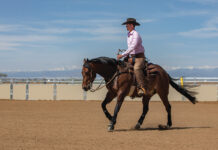All riding horses are taught to respond to pressure from the rider’s leg, whether it’s pressure telling the horse to move over or pressure telling the horse to move faster. Spurs can help enhance and fortify leg pressure cues. But before you strap on a pair of spurs, here are a few suggestions:
- Keep in mind that not every horse needs to be ridden with spurs. Sensitive and high-energy horses often respond to simple pressure from a rider’s calf or heel.
- Green horses must first comprehend the meaning of leg pressure before they’re introduced to the feel of a spur. If you ride a green or very young horse, be sure it moves forward and away from leg pressure before trying spurs.
- Some horses respond better (more willingly) to a tap from a riding crop than to a nudge from a spur. This is especially true for horses that are already sour or dull from previous riders who used spurs improperly.
- There’s an old horseman’s axiom that riders must “earn their spurs.” Keep that in mind. If you’re wearing spurs, and you inadvertently bump your heel into your horse’s ribs or flank, there could be unexpected consequences.
- When riding with spurs, remember to give your horse the opportunity to respond to more subtle leg cues first. For example, try squeezing with just your calf, and then press with your heel if necessary. Only go to your spur if your horse resists or ignores your leg. If you rely on your spurs for every leg cue, your horse will eventually tune out your requests.
- To apply pressure with your spurs, turn your toe out slightly. This will angle the end of the spur toward your horse’s side. Then bring your lower leg inward. Try to feel when the spur presses into your horse’s side; never press more than you need and never “hug” your horse’s sides with your spurs. Instead, the moment your horse responds to the spur, relax your leg and bring it back to its original position.
- You may have to temporarily raise your heel to bring the spur into contact with your horse. But if your leg position is constantly compromised then you may need to switch to a spur with a longer shank (sometimes called the neck of the spur). Long-legged riders on short or narrow-bodied horses often require spurs with longer shanks.
- Horses typically let the rider know if the spurs are being used incorrectly or too harshly. If your horse bucks or kicks out when you apply leg pressure, seems agitated and tense, or pins his ears and balks, then you probably need to reconsider the spurs you’re wearing.
Further Reading
Are Spurs for You?
The Point of Spurs
See more Horsemanship How-tos >>







Excellent article!
very useful, thanks